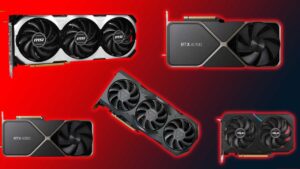Introduction
In the fast-paced realm of artificial intelligence (AI) technology, the competition for dominance in the GPU market has reached unprecedented levels in 2024.
Recent forecasts reveal a stark contrast in sales figures among key players, with NVIDIA emerging as the undisputed leader, AMD making significant strides, and Intel facing substantial challenges.
Let’s explore the intricacies of this dynamic market landscape and what it signifies for the future of AI computing.
NVIDIA is expected to dominate the AI market in 2024 as they are set to sell $40 billion worth of GPU, significantly outpacing AMD & Intel.
Follow us on Linkedin for everything around Semiconductors & AI
NVIDIA: A Resounding Triumph
NVIDIA’s projected $40 billion in AI GPU sales for 2024 signifies a monumental triumph for the company.
With a commanding lead over its competitors, NVIDIA continues to set the standard for innovation and performance in AI accelerators.
This remarkable achievement not only underscores the overwhelming demand for NVIDIA’s products but also highlights the company’s unwavering commitment to pushing the boundaries of AI technology.
At the heart of NVIDIA’s success lies its relentless pursuit of cutting-edge GPU architectures tailored specifically for AI applications.
The Blackwell GPUs, with their premium price tags ranging from $30,000 to $40,000, epitomize NVIDIA’s dedication to delivering unparalleled performance in the AI computing space.
Furthermore, the company’s substantial investment of $10 billion in developing the fastest AI chip on the planet solidifies its position as a frontrunner in the industry.
Read More: 8 Companies Poised to Benefit Significantly from the AI Boom – techovedas
AMD: A Significant Surge
While AMD may trail behind NVIDIA in projected sales, the company has made significant strides in the AI GPU market.
With forecasted sales of $3.5 billion for 2024, AMD demonstrates a notable surge in its market presence.
One key factor driving AMD’s momentum is its Instinct lineup of accelerators, which has garnered widespread interest from industry players.
The Instinct MI300X AI GPU, in particular, has received acclaim for its competitive price-to-performance ratio and consistent supply.
Despite facing challenges, such as its absence from the latest MLPerf v4.0 benchmarks, AMD remains a formidable contender in the AI GPU market.
With ongoing innovation and strategic initiatives, AMD is well-positioned to capitalize on future opportunities and further solidify its foothold in the industry.
Read More: Google Reaches Unprecedented $2 Trillion Market Cap Milestone – techovedas
Intel: A Struggle for Relevance
In stark contrast to its competitors, Intel faces significant challenges in the AI GPU market, with projected sales of just $500 million for 2024.
Despite the introduction of the Gaudi-3 AI accelerators, Intel’s revenue falls far short of market expectations.
Factors such as the utilization of older components like HBM2e and limited market penetration contribute to Intel’s struggles in gaining traction.
However, there remain potential pathways for Intel to revitalize its position in the market. By exploring alternative strategies and leveraging opportunities in emerging markets, Intel could potentially overcome its current challenges and regain momentum.
The company’s ability to adapt and innovate will be crucial in navigating the evolving landscape of AI computing.
Read More: How Gold Plays a Surprisingly Important Role in Nvidia’s GPUs – techovedas
Emerging Trends and Opportunities
Beyond the performance metrics and revenue projections, several emerging trends and opportunities shape the AI GPU market in 2024:
- Edge Computing: The proliferation of edge computing applications presents new opportunities for AI GPU vendors to cater to the growing demand for on-device AI processing.
- Specialized Accelerators: As AI workloads become increasingly diverse and complex, there is a growing demand for specialized accelerators optimized for specific tasks, such as natural language processing (NLP) and computer vision.
- AI Infrastructure: The development of AI infrastructure, including data centers and cloud computing platforms, creates a fertile ground for GPU vendors to expand their reach and establish strategic partnerships.
- Regulatory Landscape: Evolving regulatory frameworks, particularly around data privacy and AI ethics, may influence the adoption and deployment of AI GPU technologies in various industries.
Read More: Threat for Spotify: Amazon Maestro Learns Your Taste and Create Custom Music – techovedas
Conclusion:
The forecasted sales figures for 2024 paint a vivid picture of the AI GPU market, with NVIDIA leading the charge, followed by AMD and Intel. As the demand for AI accelerators continues to soar, each company faces unique opportunities and obstacles in navigating this dynamic landscape.
For NVIDIA, maintaining its technological superiority and market dominance will be paramount, while AMD seeks to capitalize on its momentum and expand its market share. Meanwhile, Intel must strategize to overcome its current challenges and carve out a more competitive position in the industry.
In this ever-evolving landscape, innovation, adaptability, and strategic foresight will be critical drivers of success. As companies continue to push the boundaries of AI computing, the stage is set for a dynamic and fiercely competitive market in the years to come.



